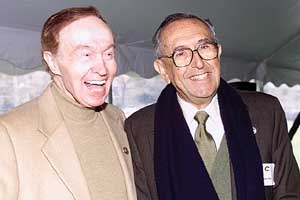Art of architecture expressed in new Ratner Center
By Peter SchulerNews Office
 Gerald Ratner (left) and Cesar Pelli |
Pelli’s design for the University’s first new athletic facility in 68 years is an arresting architectural vision—with sloping glass walls, a dramatic curved roof and soaring masts that offer visual excitement from every angle—but one that ties intimately to the Gothic buildings in the heart of the campus.
The center is a collaborative effort between Cesar Pelli & Associates and the Chicago firm of OWP/P. Pelli explained how he and OWP/P arrived at the building’s concept. “The building connects with the traditional Gothic structures at the University at a deep intellectual level,” he said.
“The essence of Gothic structure was in its expression of structural forces external to the body of the building, most notably in the form of flying buttresses that allowed for exceptionally tall and luminous spaces. Flying buttresses are perhaps the most characteristic form-giving element of Gothic buildings. In the Gerald Ratner Athletics Center, the structure also is external to the body of the building: it is its most salient characteristic and the primary maker of the image of the building,” said Pelli.
A massive construction project that required 2,000 tons of steel alone, the new center features 125-foot-tall steel masts that support approximately 2 million pounds of roof. The masts, imported from Germany, are tied together by 120 high-strength steel cables, which add up to nearly 6,500 feet in length. Massive counterweights containing 2,500 cubic yards of concrete—with some as large as 50-feet long, 25-feet wide and 13-feet thick—are buried in the ground and counteract the weight of the roof.
Curt Heuring, University Architect, worked closely with Pelli and OWP/P throughout the planning, design and construction process. “The unique roof framing system affords a visually light and elegant roof structure,” said Heuring. “There are no standard beams made that would span the length of the gym or the pool without dropping to the floor, which is why the mast and cable support system was essential.”
John Briazzi, senior associate and architect for OWP/P, commented on the building’s artistry and function. “The building is an example of the art of architecture being expressed, not only through its use of building materials, but through its integration of building structure and mechanical systems. It is a unique building that creates a center for student and University community life,” Briazzi added.
The pool, in the words of Tom Weingartner, Associate Professor and Chairman of Physical Education & Athletics, is “the jewel” of the new facility. The 50-meter, handicapped-accessible pool has been constructed with a unique profile designed with shallow water in the center to maximize flexibility of use and can accommodate three different length-race courses at either end—25 yards, 25 meters and 50 yards.
The University opened the doors to the Gerald Ratner Athletics Center to the University community on Monday, Sept. 29, and will officially dedicate the structure at a ceremony during Homecoming activities, Saturday, Oct. 11.
The special guests who will join President Randel and James Crown, Chairman of the University Board of Trustees, are Gerald Ratner, the center’s principal donor; Pelli, the architect of the building; and senior staff of OWP/P, the Chicago firm that worked with Pelli & Associates on the design.
Gerald Ratner, Ph.B.,’35, J.D.,’37, a scholar-athlete when he was a student at the University and now a distinguished attorney, said, “I did this as my way of giving back to the University for what it gave to me. It was the springboard for my career. I felt that any gift to this great University would, in turn, be magnified and multiplied a thousand times by what its outstanding graduates and faculty could do for the world.” Ratner’s $15 million gift was the largest contribution toward the $51 million project.
![[Chronicle]](/images/sidebar_header_oct06.gif)